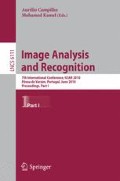Abstract
Graph cut minimization formulates the segmentation problem as the liner combination of data and smoothness terms. The smoothness term is included in the energy formulation through a regularization parameter. We propose that the trade-off between the data and the smoothness terms should not be balanced by the same regularization parameter for the whole image. In order to validate the proposed idea, we build a system which adaptively changes the effect of the regularization parameter for the graph cut segmentation. The method calculates the probability of being part of the boundary for each pixel using the Canny edge detector at different hysteresis threshold levels. Then, it adjusts the regularization parameter of the pixel depending on the probability value. The experiments showed that adjusting the effect of the regularization parameter on different image regions produces better segmentation results than using a single best regularization parameter.
Access this chapter
Tax calculation will be finalised at checkout
Purchases are for personal use only
Preview
Unable to display preview. Download preview PDF.
References
Comaniciu, D., Meer, P.: Mean Shift: A Robust Approach Toward Feature Space Analysis. IEEE Trans. Pattern Anal. Mach. Intell. 24(5), 603–619 (2002)
Kass, M., Witkin, A., Terzopoulos, D.: Snakes: Active contour models. International Journal of Computer Vision 1(2), 321–331 (1987)
Shi, J., Malik, J.: Normalized Cuts and Image Segmenatation. IEEE Trans. Pattern Anal. Mach. Intell. 22(8), 888–905 (2000)
Greig, D.M., Porteous, B.T., Seheult, A.H.: Exact Maximum A Posteriori Estimation for Binary Images. J. Royal Statistical Soc., Series B 51(2), 271–279 (1989)
Boykov, Y., Veksler, O., Zabih, R.: Fast approximate energy minimization via graph cuts. IEEE Trans. Pattern Anal. Mach. Intell. 23, 1222–1239 (2001)
Hadamard, J.: Sur les problèmes aux dérivées partielles et leur signification physique. Princeton University Bulletin, Princeton (1902)
Bertero, M., Poggio, T.A., Torre, V.: Ill-posed problems in early vision. Proceedings of the IEEE 76(8), 869–889 (1988)
Boykov, Y., Jolly, M.P.: Interactive graph cuts for optimal boundary and region segmentation of objects in N-D images. In: IEEE Conf. on Computer Vision, vol. 1, pp. 105–112 (2001)
Rother, C., Kolmogorov, V., Blake, A.: GrabCut-Interactive foreground extraction using iterated graph cuts. ACM Trans. Graph. 23(3), 309–314 (2004)
Tikhonov, A.N., Arsenin, V.A.: Solutions of ill-posed problems. Winston, Washington (1977)
Hansen, P.C.: Deconvolution and regularization with toepliz matrices. Numerical Algorithms 29, 323–378 (2002)
Krawczyk-Stando, D., Rudnicki, M.: Regularization parameter selection in dicrete ill-posed problems - the use of the U-curve. Int. J. Appl. Math. Comput. Sci. 17(2), 157–164 (2007)
Irizarry, R.A.: Choosing smoothness parameters for smoothing splines by minimizing and estimate of risk. Johns Hopkins University, Dept. of Biostatistics Working Papers. Working Paper 30 (2004)
Thompson, A.M., Brown, J.C., Kay, J.W., Titterington, D.M.: A study of methods of choosing the smoothing parameter in image restoration by regularization. IEEE Trans. Pattern Anal. Mach. Intell. 13(4), 326–339 (1991)
Krajsek, K., Mester, R.: Maximum Likelihood Estimator for Choosing the Regularization Parameters in Global Optical Flow Methods. In: IEEE International Conference on Image Processing, pp. 1081–1084 (2006)
Zhang, L., Seitz, S.M.: Estimating optimal parameters for MRF stereo from a single image pair. IEEE Trans. Pattern Anal. Mach. Intell. 29(2), 331–342 (2007)
Peng, B., Veksler, O.: Parameter selection for graph cut based image segmentation. In: Proceedings of the British Machine Vision Conference (2008)
Vicente, S., Kolmogorov, V., Rother, C.: Graph cut based image segmentation with connectivity priors. In: IEEE Conference on Computer Vision and Pattern Recongnition, pp. 1–8 (2008)
Author information
Authors and Affiliations
Editor information
Editors and Affiliations
Rights and permissions
Copyright information
© 2010 Springer-Verlag Berlin Heidelberg
About this paper
Cite this paper
Candemir, S., Akgül, Y.S. (2010). Adaptive Regularization Parameter for Graph Cut Segmentation. In: Campilho, A., Kamel, M. (eds) Image Analysis and Recognition. ICIAR 2010. Lecture Notes in Computer Science, vol 6111. Springer, Berlin, Heidelberg. https://doi.org/10.1007/978-3-642-13772-3_13
Download citation
DOI: https://doi.org/10.1007/978-3-642-13772-3_13
Publisher Name: Springer, Berlin, Heidelberg
Print ISBN: 978-3-642-13771-6
Online ISBN: 978-3-642-13772-3
eBook Packages: Computer ScienceComputer Science (R0)

